|
Open sea cage technology developed by CMFRI
Cage farming in India
As an R & D activity, the first open sea cage was launched in Bay of Bengal off Visakhapatnam coast during May 2007. Due to the rough sea conditions, the first version of the cage had lasted only for 45 days in the sea. With further modifications, the second version of marine cage was fabricated involving marine engineering and naval diving experts and was launched in December 2007. With a low stocking density, the trial was successfully completed in April 2008. The recovery percentage was 75% and the weight ranged from 300-1200g. The third version of the cage was also tried and found to be seaworthy at any extreme sea conditions. The first to third versions were 15 m dia HDPE cages. For easy manoeuvring and cost effectiveness in terms of reduced labour, the size of the HDPE cages have been modified to 6 m in the fourth version. In a demonstration trial, these types of cages have been found to be successful in many maritime states along the Indian coast. Latest version of open sea cage is a cost effective GI cage designed for low investment farming operations. |
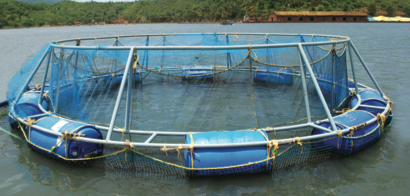 |
Open sea cage technology
Different criteria must be addressed before site selection for cage culture The first is primarily concerned with the physico- chemical conditions like temperature, salinity, oxygen, currents, pollution, algal blooms, water exchange etc. that determine whether a species can thrive in an environment. Other criteria that must be considered for site selection are weather conditions, shelter, depth, substrate etc. Finally legal aspects, access, proximity to hatcheries or fishing harbor, security, economic, social and market considerations etc. are to be taken care. |
Size
It is a fact that costs per unit volume decrease with increasing cage size, within the limits of the materials and construction methods used. However, very large cages may limit stocking, grading and harvesting options, and maintenance aspects like net changing and disease treatment also become increasingly difficult as size of cages increase. CMFRI has developed open sea cages of 6 m dia and 15 m dia for grow out fish culture and 2 m dia HDPE cages for seed rearing. Ideal size for grow out cage is 6 m due to its easy manoeuvring and reduced labour. For fingerling 2 m cages can be used. |
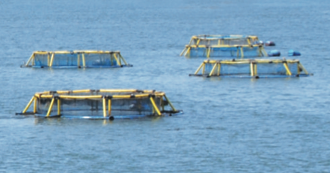 |
Cage frames and nets
Culture experiments and demonstrations using different cage materials have been carried out by CMFRI. Business entrepre neurs with high capital investments long lasting and expensive High Density Poly Ethylene (HDPE) frames can be used. Small groups and fishermen can opt for cost effective epoxy coated Galvanized Iron (GI) frames. GI frames have less life span com pared to HDPE frames.
Nets of varying dimensions and materials were tested for cage culture in India. CMFRI has used braided and twisted HDPE nets for grow out purpose. It can last for two or more seasons. Nylon net can be used economically, but since it is light weight, to hold the shape intact more weight has to be loaded in the ballast pipe. Sapphire is also good because of its high breaking strength compared to HDPE and nylon. Cost factor has to be taken care while using sapphire or dyneema materials for net cage. The depth of net ranging from 2 to 4 m for fingerlings and 5 to 6 m for grow out cages are ideal. For open sea cage culture, predator net to prevent attack by predatory organisms is essential. |
Potential species and criteria for selection of species for cage culture
The selection of species for cage culture should be based on a number of biological criteria like omnivore or carnivore, hardiness, fast growing, efficient food conversion ability, availability of eggs and juveniles, and disease resistance. Economic marketability and demand are also taken into consideration. Mariculture is a relative latecomer in the food production industry in the world. Following positive experiences in production of salmonids in floating cages at high densities in European countries, marine finfish farming in cages was successfully initiated in coastal waters of Mediterranean countries as well.
In India, marine fish present problems for the fish culturists since fry supply still remains as a bottle-neck in expanding of industrial mariculture. Marine fish eggs and small size larvae at first feeding make it too complicated a matter to rear them throughout their life cycles. Culture of marine fish has taken up only due to the promotion of cage culture of sea bass by CMFRI and to the improvement of the hatchery techniques by RGCA (MPEDA) which has enabled the fry production under a controlled price. Asian seabass L. calcarifer has been proven as a fine species for cage culture due to the availability of hatchery produced seed, market demand and fast growth. Another species which has great potential is cobia Rachycentron canadum, for which hatchery technology has been initiated by CMFRI. Once the technology is commercialized, cobia will snatch the scene of mariculture in India due to its fast growth and excellent market value.
Among crustaceans, lobster rearing in open sea cages has been proved highly lucrative. CMFRI has demonstrated lobster rearing in cages at Vizhinjam, Kanyakumari, Mandapam and Veraval. Within a short span of 3 months fishermen were able to raise more than four times revenue by lobster rearing. Otherwise, juveniles of lobsters are sold for meagre amount in the local market. This practice also leads to reduction in loss of natural stock due to juvenile capture which is not uncommon in Indian waters. |
Stocking
Although stocking densities should be determined by species requirements and operational considerations, the influence of stocking densities on growth and production has been determined empirically. The stocking density depends also onthe carrying capacity of the cages and the feeding habits of the cultured species. Optimal stocking density varies with species and size of fish. For producing 5 tonnes of 500-600 g seabass from a 6 m dia. HDPE cage, 30-50 individuals (100 g) per cubic meter can be stocked.
Feeds and feed management
Fresh or frozen trash fish, moist pellet (MP) and floating dry pellets are the common feed for growing fish in cages. Feeding in cages is quite easy compared to that in ponds. The ration can be divided into equal portions and supplied at regular intervals. Feeding can be done either by broadcasting or using feeding trays. |
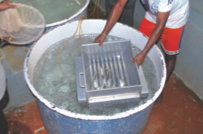 |
Harvest
Harvest of fish or lobster in cages is made very easy compared to that in ponds. Cages can be towed to a convenient place and harvest can be carried out. Also based on demand, partial or full harvest can be done. |
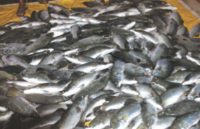 |
Cage management
Cage culture management must result in optimizing production at minimum cost. The management should be so efficient that the cultured fish should grow at the expected rate with respect to feeding rate and stocking density, minimize losses due to disease and predators, monitor environmental parameters and maintain efficiency of the technical facilities (Chua, 1982). Physical maintenance of cage structures is also of vital importance. The raft and net-cages must be routinely inspected. Necessary repairs and adjustments to anchor ropes and net-cages should be carried out without any delay. Monthly exchange of net should also be considered, as this ensures a good water exchange in the net, thereby washing away feces, uneaten food and to a certain extent reduce the impact of fouling. |
Fouling of cage net
Fouling of cage nets and other structures has been observed at many instances of cage farming. Nets get covered with bio- foulers. Fouling by molluscs, especially edible oysters and barnacles have to be checked before its growth advancement. Algal mats and other periphytons can be removed by introduction of omnivorous grazers in cages. A fouled net will be heavier, thereby increasing drag, and this result in loss of nets and fish.
To avoid/ reduce fouling, net should be changed as and when required, which may vary from 2 to 4 weeks depending on the intensity of fouling. During oyster fouling, net exchange has to be done immediately after the seasonal spat fall.
Herbivorous fish such as rabbit fish (Siganus spp.), pearl spots (Etroplus spp.) and scat (Scatophagus sp.) can be used to control biofoulers (Beveridge, 1987), but their application on a large scale needs to be assessed. |
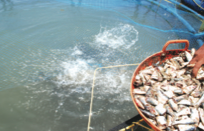 |
Disease monitoring
Monitoring of fish stock health is essential and early indi cations can often be observed from changes in behavior, especially during feeding.
TechnicaL issues in developing open sea cage farms in Indian waters
- Lack of sea farming policy is a major issue which has to be taken care by the concerned states in the country before taking up commercial cage farming.
- Modification of the cage design to withstand strong sea currents/ tidal flow and retain their effective volume; developing cages that are better suited to the sea conditions in different regions and to different species.
- Developing stronger cage-nets that can withstand varying sea conditions and fouling.
- Producing associated facilities and equipment, including that for safety and security of the structure and stock, feeding, grading, net-cleaning, monitoring, harvesting etc.
- Developing cost-effective and nutritionally complete formulated feed to replace the trash fish that is used at present. Formulated feed has been used in aquaculture for more than
30 years, but is not widely used in marine cage culture.
Capture based aquaculture
Capture based aquaculture (CBA) is a good concept for species for which hatchery technology has not been developed. Southern blue fin tuna (Thunnus spp) is cultured in Australia using wild- caught juveniles, which has great demand in global market. In India also many species can be cultured in a similar way. The juveniles of high valued species caught in different gears if brought alive can be effectively used for CBA in cages. Juveniles of koth, ghol, pomfret, pompano, snappers etc. can be used for CBA. The only precaution to be taken is that CBA should not target to any single species, which might lead to vulnerability to endangering/ extinction in future. CBA enhances marine fish production and reduce the wastage of resource as low value by catch and regular supply of high quality seafood items.
Constraints that may occur in open sea cage culture
- Biological,mainlydiseaseproblems,andbiodiversityconcerns due to the introduction of new species in the region.
- Market constrains, such as fluctuation of prices based on supply, quality control problems, demand for aquaculture products, etc.
- Zoo-technical constraints, such as seasonality of production
- Environmental concerns, linked to the location of farms and the impact of their effluents on the surrounding environment
(in commercial ventures only)
- Scarcity of potential sites for new aquaculture projects, and
competition with other coastal users (urbanization, tourism, navigation, wildlife park projects, harbours, maritime traffic, etc.) and Scarce administrative organization with regards to the integra tion of aquaculture activities in coastal areas.
|
Source :
Handbook on open sea cage culture
Central Marine Fisheries Research Institute Karwar Research Centre
Cage Culture -Mariculture Technology of the Millennium in India
G. Syda Rao
Updated on : Feb 2015 |

